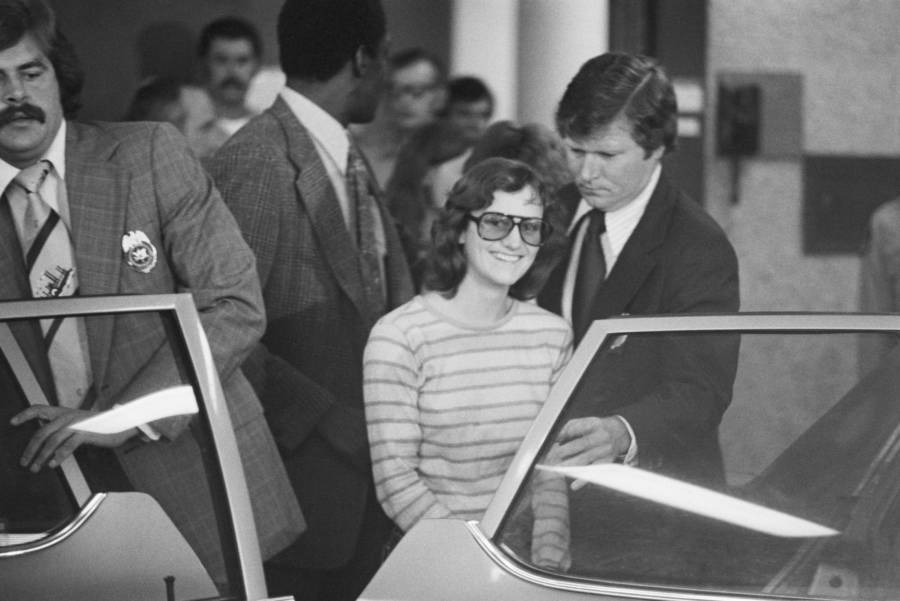How did wealthy heiress Patty Hearst become a violent member of a left-wing guerrilla group — that kidnapped her?
In 1974, a group of leftist radicals calling themselves the “Symbionese Liberation Army” stormed into the Berkeley, California apartment of 19-year-old publishing heiress Patty Hearst. They beat her fiancé with a wine bottle, tied up Hearst, and dragged the terrified teen into the night. What happened next has since become the stuff of American legend.
In just a couple of months, Hearst, the granddaughter of media mogul William Randolph Hearst, seemed to change drastically in captivity. She released audio tapes announcing her allegiance with the Symbionese Liberation Army, helped rob a bank, and took on a new name: “Tania.”

San Mateo County Sheriff’s Office/Wikimedia CommonsPatty Hearst’s booking photo following her arrest in San Francisco. September 19, 1975.
By the time she was arrested in September 1975, Hearst seemed like a woman transformed. As she was booked into jail, the once-apolitical heiress told the police that her occupation was “urban guerrilla.”
During her trial, however, Hearst’s legal team insisted that she’d been a victim of brainwashing, intimidation, and abuse. And even though she was found guilty of armed bank robbery and sentenced to prison, Hearst’s term was commuted by President Jimmy Carter in 1979. A little over two decades later, President Bill Clinton offered her a pardon.
But to this day, considerable mystery surrounds Patty Hearst’s abduction — and her brief yet dramatic transformation into a radical.
Patty Hearst’s Privileged Upbringing

Hulton Archive/Getty ImagesPatty Hearst, pictured before her kidnapping. Circa 1973.
Patricia Campbell Hearst was born on February 20, 1954, in San Francisco, into a life of considerable wealth. She was the granddaughter of newspaper publisher William Randolph Hearst, who was worth over $200 million when he died in 1951 (approximately $2.2 billion in today’s money).
She grew up, in her own words, in an “affluent and sheltered environment” and enjoyed a childhood that was “pretty perfect.”
That said, Hearst was also known for her rebellious nature and for bending the rules. According to The New York Times, an expert witness for the prosecution during her trial testified that Hearst had experimented with LSD and marijuana, had sex at an early age, and even lied to teachers at her high school about her mother having cancer to get out of a test.
While she was still in high school, 16-year-old Patty Hearst met Steven Weed, who was then a 23-year-old teacher. Weed tutored Hearst in math and the two eventually began a relationship. Hearst and Weed became engaged in 1973 and moved into a Berkeley apartment together, despite the strong disapproval of Hearst’s parents.

Hulton Archive/Getty ImagesPatty Hearst and Steven Weed, pictured before her kidnapping. Circa 1973.
Hearst wasn’t all that happy with the relationship herself. According to Jeffrey Toobin, who wrote American Heiress: The Wild Saga of the Kidnapping, Crimes and Trial of Patty Hearst, Hearst had begun to sour on Weed, but she didn’t want to prove her parents right by breaking up with him. She felt “mildly suicidal” as she contemplated her future.
Then, Patty Hearst’s future took a turn that no one could have predicted.
The Kidnapping And Radical Transformation Of Patty Hearst
On February 4, 1974, members of the Symbionese Liberation Army (SLA) gathered outside of Hearst’s Berkeley apartment. The small leftist guerrilla group, founded in 1971, was formed of radicals who proclaimed the slogan: “Death to the fascist insect that preys on the life of the people.” According to Slate, the SLA wholeheartedly embraced the concept of “urban propaganda,” which called for violent acts that captured media attention.
The SLA never included more than a dozen people. And compared to other radical organizations of the 1960s and 1970s, the group would ultimately have little impact. But on that February night, SLA members would execute one of the most infamous kidnappings in American history.

FBI/Wikimedia CommonsAn FBI wanted poster providing information about Symbionese Liberation Army members, including Patty Hearst.
According to American Heiress, Patty Hearst and Steven Weed were at home when their doorbell rang at 9:17 p.m. After Weed opened the door, SLA members forced their way into the apartment, brutally attacked Weed, bound and gagged Hearst, and escaped into the night with their hostage.
The kidnappers drove to a hideout in Daly City, California, where Hearst was kept in a closet. According to CNN, Hearst had heard of the SLA — they had infamously murdered Oakland superintendent Marcus Foster, the city’s first Black school superintendent, for his “fascist” support of making schoolchildren carry ID cards — and knew to fear her captors.
But even if she’d never heard of the SLA, they soon gave her reason to fear them. According to Hearst, her kidnappers abused and raped her.
“They debilitate you by locking you up,” Hearst later remembered in a 1988 interview. “You’re deprived of sight, light, sleep, and food. You depend on them for all information… And the dread is just the threat constantly you’ll be killed if you don’t cooperate.”

Mickey Pfleger/The LIFE Images Collection/Getty ImagesThe exterior of one of the hideouts where Patty Hearst was held captive by the Symbionese Liberation Army.
The SLA initially planned to exchange Hearst for Joseph Remiro and Russell Little, who had been arrested for Foster’s murder. But they soon changed course and announced that they were holding Patty Hearst hostage until her family members used their wealth to distribute food to the poor.
Surprisingly, this was easier said than done. Though Hearst’s grandfather had been significantly wealthy, he’d funneled most of his riches into the Hearst Corporation and other trusts. Because of this, Patty Hearst’s family had to scrape together their own money, and rely on a donation from the Hearst Foundation, to set up a food drive — which spiraled into a riot.
Then, in April, Patty Hearst released an alarming audio tape:
“I have been given the choice of one, being released in a safe area, or two, joining the forces of the Symbionese Liberation Army and fighting for my freedom and the freedom of all oppressed people. I have chosen to stay and fight.”
Among the SLA, she was no longer known as Patty Hearst, but as “Tania.”
The Rise And Fall Of “Comrade Tania”

Bettmann/Contributor/Getty ImagesPatty Hearst posing with a machine gun in front of a Symbionese Liberation Army flag.
On April 15, 1974, Patty Hearst — a.k.a. Tania — seemed to back up her words. Then, Hearst and other SLA members descended on a Hibernia Bank branch in San Francisco. They robbed the bank of $10,000, and Hearst was filmed at the crime scene holding a machine gun.
She purportedly introduced herself as “Tania” and shouted, “First person puts up his head, I’ll blow his motherf**king head off!”
To some, this out-of-character behavior was evidence that Hearst had been brainwashed by the SLA. To others, it offered clear proof that she’d willingly joined the group and fully embraced its radical mission.
“I said my name and — because I was supposed to say my name and make a speech, but it’s all pretty unclear,” Hearst later recalled. “And then, [SLA member] Donald DeFreeze shot someone, and then everything went blank… My next memory is sitting in the car leaving [the bank].”
In her autobiography, Hearst added how she felt after the incident: “I sensed that I had, in fact, crossed over some sharp line of demarcation… For me, suddenly it became plain: There was no turning back.”
Then, in May 1974, Hearst was waiting for two SLA members outside of a sporting goods store in Los Angeles when they were detained for shoplifting. To help them escape, Hearst fired multiple bullets outside. Many would later point to this incident as further evidence that she believed in the SLA’s cause, as this could’ve been an opportunity for her to escape them.
However, her actions did inadvertently help the authorities, who’d been having difficulty tracking the SLA. A parking ticket accidentally left behind by Hearst and the SLA members led police to one of the SLA’s hideouts in Los Angeles. An ensuing shootout between the SLA and the LAPD led to the deaths of six SLA members. But Patty Hearst wasn’t there.
Hearst wasn’t arrested until September 18, 1975, about 19 months after her initial kidnapping. Soon after that, she would be put on trial — and many would raise questions about her culpability in the SLA’s crimes.
Innocent Victim Or Willing Participant?

Bettmann/Contributor/Getty ImagesPatty Hearst leaves San Mateo County Jail in Redwood City, bound for her appearance in federal court in San Francisco. September 19, 1975.
In a sensational trial, Patty Hearst’s legal team claimed that she’d been brainwashed by her captors. They also said she feared that she’d be killed if she didn’t participate in the SLA’s crimes. But a jury didn’t buy it.
The heiress was ultimately found guilty of armed bank robbery and the use of a firearm in the commission of a felony in 1976. She was sentenced to seven years in prison for her actions while in the SLA.
Her sentence, however, was commuted by President Jimmy Carter in 1979, and Hearst was granted a full pardon by President Bill Clinton in 2001.
To this day, Patty Hearst remains a beguiling figure. Was she an innocent victim, kidnapped and forced to do the SLA’s bidding, as she and her lawyers claimed? Or was she a willing participant, unhappy in her relationship and adrift in life, who found meaning in their radical cause?
Only Patty Hearst — or Tania — knows the answer to that.
After this look at the Patty Hearst kidnapping and the Symbionese Liberation Army, read up on some more of the 20th century’s most infamous female criminals and killers. Then, see some of the 1970s’ most iconic photos.





